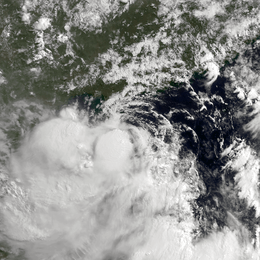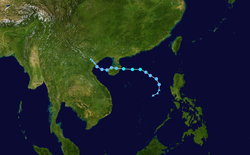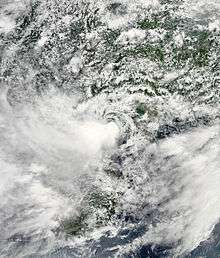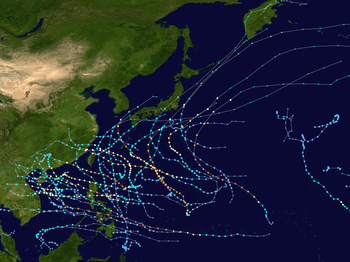Tropical Storm Bebinca (2013)
Tropical Storm Bebinca, known in the Philippines as Tropical Depression Fabian, was a weal tropical cyclone that brought minor damage in China and Vietnam, which caused a death and an economic loss of about US$13 million.[2][3]
| Tropical storm (JMA scale) | |
|---|---|
| Tropical storm (SSHWS) | |
 Tropical Storm Bebinca at peak intensity near Hainan on June 22 | |
| Formed | June 19, 2013 |
| Dissipated | June 24, 2013 |
| Highest winds | 10-minute sustained: 75 km/h (45 mph) 1-minute sustained: 65 km/h (40 mph) |
| Lowest pressure | 990 hPa (mbar); 29.23 inHg |
| Fatalities | 1 total, 2 missing[1] |
| Damage | $13.6 million (2013 USD) |
| Areas affected | |
| Part of the 2013 Pacific typhoon season | |
Meteorological history

In mid-June, strong but disorganized convection persisted in the South China Sea approximately 1,110 km (690 mi) south of Hong Kong.[4] The disturbance gradually organized, and was classified as a tropical depression by the Japan Meteorological Agency (JMA) at 1800 UTC on June 19;[5] The Philippine Atmospheric, Geophysical and Astronomical Services Administration (PAGASA) followed suit six hours later, naming the system Fabian.[6] Despite wind shear generated by a subtropical ridge, the depression maintained a well-defined circulation, allowing the system to intensify.[7] At 0000 UTC on June 21, the JMA upgraded the cyclone to Tropical Storm Bebinca.[8] Following this upgrade in strength, however, Bebinca leveled out in intensity prior to making landfall on Hainan on June 22. Bebinca's passage weakened the system to tropical depression strength, and, despite moving over the Gulf of Tonkin, failed to restrengthen before making a final landfall on June 23 east of Hanoi.[9]
Impact
Hainan

Due to the potential effects of Bebinca, Sanya Phoenix International Airport cancelled or delayed 147 inbound and outbound flights, leaving 8,000 passengers stranded.[10] In Beibu Bay, a fishing boat with four fishermen on board lost communication contact with the mainland, but were found the subsequent day.[11][12] Rainfall in Hainan peaked at 227 mm (8.9 in) in Sanya. A total of 21.7 million people were affected, and damage amounted to ¥10 million (US$1.63 million).[3]
Vietnam
At Do Son, Haiphong, it rained heavily and the late afternoon tide appeared large. High water flooded many residential areas, including the entire area Ngoc Hai. Markets sagged in the country. As noted, somewhere close to 1m of surges flooded the chest. Many families could not move the furniture that had been swept into the water.[13] 50m quay wharf embankment Fat, Cat Ba Island, 40m embankment resorts Do Son eroded. Cat Hai embankments were combined with storm surge swept inflict damage positions. The whole city has more than 2,300 ha and 40 ha of aquatic crops damaged by burst its banks, flooding.[14]
Heavy rains affected several provinces in northern Vietnam after moving over the Gulf of Tonkin. A peak gust of 26 m/s was recorded at Hon Dau. The biggest amount of precipitation during the time of the tropical storm, Bebinca, was peaking at 208 mm (8.2 in) in Ninh Bình.[1][15] Its impacts were also confined to the agricultural industry as more than 4,600 hectares (11,400 acres) of fish, shrimp, crab and oyster ponds were damaged. Total economic losses were listed at VND 250 billion (US$12 million).[2] One person was killed and two others missing due to the flood in Nghệ An Province.[1]
Director of Thái Bình Province's Radio – Television Vu Anh Thao, leaders this province was temporarily suspended from work for 15 days to clarify responsibilities. Vice Chairwoman of Thái Bình province Cao Thi Hai says:[16]
- The reason is because today the province and industry leaders to examine the locality the storms, Thái Bình province's people say that they do not propagate and subjective information. "Such propaganda is not timely. Luckily, the storm did not make landfall on the right if the consequences will be severe.
See also
- Tropical Storm Jebi (2013)
- Tropical Storm Kujira (2015)
- Tropical Storm Dianmu (2016)
References
- Vietnamese National Center for Hydro Meteorological Forecasts (December 11, 2013). Member Report: Vietnam (PDF). ESCAP/WMO Typhoon Committee: 8th Integrated Workshop/2nd TRCG Forum. ESCAP/WMO Typhoon Committee. Archived from the original on December 11, 2013. Retrieved December 11, 2013.
- June 2013 Global Catastrophe Recap AON Benfield. Page 7. Retrieved on January 4, 2014.
- China Meteorological Administration (November 22, 2013). Member Report: China (PDF). ESCAP/WMO Typhoon Committee: 8th Integrated Workshop/2nd TRCG Forum. ESCAP/WMO Typhoon Committee. p. 16. Archived from the original on November 26, 2013. Retrieved November 26, 2013.
- "Significant Tropical Weather Advisory for the Western and South Pacific Oceans June 18, 2013 20z". Joint Typhoon Warning Center. June 18, 2013. Archived from the original on June 18, 2013. Retrieved October 1, 2013.
- Tropical Storm Bebinca (RSMC Tropical Cyclone Best Track). Japan Meteorological Agency. July 17, 2013. Archived from the original on July 17, 2013. Retrieved October 1, 2013.
- "Tropical Cyclone Alert: Tropical Depression "Fabian": Number One June 20, 2013 03z". Philippine Atmospheric, Geophysical and Astronomical Services Administration. Archived from the original on June 20, 2013. Retrieved October 1, 2013.
- "Prognostic Reasoning for Tropical Storm 05W Warning Nr 3 June 20, 2013 09z". Joint Typhoon Warning Center. June 20, 2013. Archived from the original on June 22, 2013. Retrieved October 1, 2013.
- "RSMC Tropical Cyclone Advisory TS Bebinca (1305) June 21, 2013 00z". Japan Meteorological Agency. Archived from the original on June 21, 2013. Retrieved October 1, 2013.
- "SA GITNA NG BAGYO: TS Bebinca Update #5 (LANDFALL)". Sagitnangbagyo.blogspot.co.uk. June 23, 2013. Retrieved October 1, 2013.
- Xuequan, Mu (June 22, 2013). "8,000 passengers stranded as tropical storm Bebinca hits S China". Sanya, China. Xinhua. Retrieved October 1, 2013.
- "4 fishermen missing after Bebinca reaches S China". Xinhua. June 22, 2013. Retrieved October 1, 2013.
- Xuequan, Mu (June 22, 2013). "Four missing fishermen found in S China". Haikou, China. Xinhua. Retrieved October 1, 2013.
- Bão Bebinca: Gió quật bay xe, nước tràn ngập nhà (in Vietnamese). VTC News. Retrieved on January 4, 2014.
- Nhiều đoạn đê kè sạt lở do mưa bão (in Vietnamese). Vnexpress. June 24, 2013. Retrieved at January 4, 2014.
- "Bão số 2 đã suy yếu thành vùng áp thấp" (in Vietnamese). CAND Online. June 24, 2013. Retrieved October 1, 2013.
- Giám đốc Đài PTTH Thái Bình bị đình chỉ công tác (in Vietnamese). VnExpress. Retrieved at 2014-01-04.
External links
| Wikimedia Commons has media related to Tropical Storm Bebinca (2013). |
- JMA General Information of Tropical Storm Bebinca (1305) from Digital Typhoon
- JMA Best Track Data of Tropical Storm Bebinca (1305) (in Japanese)
- JTWC Best Track Data of Tropical Storm 05W (Bebinca)
- 05W.BEBINCA from the U.S. Naval Research Laboratory
